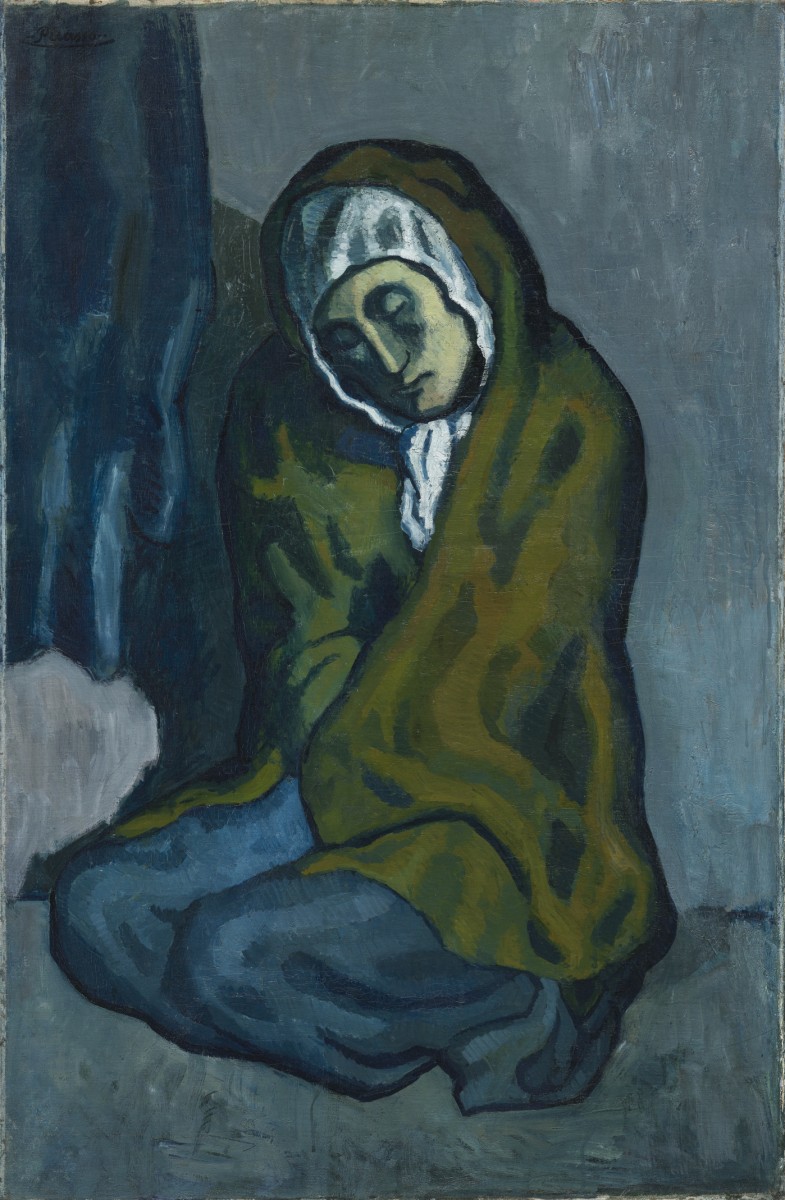Picasso’s modernista influences
An essay by Kenneth Brummel, AGO Associate Curator, Modern Art, highlights the young Picasso’s reverence for Golden Age master El Greco.
Picasso: Painting the Blue Period offers unique insight into the work of the modern master between the years 1901–1904. Only a teenager at that time, the fledgling artist was in search of his own voice while responding to the art of his contemporaries and predecessors. Topping that list are the first and second-generation modernista painters of Barcelona and the Spanish Golden Age artist El Greco. In “‘Yo, El Greco’: The Ambition of Crouching Beggarwoman”, one of the two essays he contributed to Picasso: Painting the Blue Period’s exhibition catalogue, AGO Associate Curator, Modern Art, Kenneth Brummel explains how the young Picasso’s interest in Barcelona modernista painting and the artistic legacy of El Greco both directly contributed to the creation of the 1902 masterpiece Crouching Beggarwoman, a celebrated part of the AGO Collection.
At 17, Picasso created a sheet of caricatures that contains references to his core influences. At the centre of the sheet is a woman in the style of his Barcelona modernista contemporaries. According to Brummel, “Rendering this modern woman’s stark profile with thick, emphatically drawn black strokes typical of the modernista style, Picasso signalled his allegiance to avant-garde artists such as Isidre Nonell.” At the same time, Picasso’s sketch spoke more emphatically about his admiration for the Golden Age master painter El Greco. On both sides of the work, he inscribed the phrase “Yo, El Greco” [“I, El Greco”], boldly aligning himself with his 16th-century predecessor, whom Brummel describes as “the patron saint of the Catalan modernistes.”
In a September 1902 review of Spanish art exhibitions in Paris, poet and art critic George Faillet wrote that Spain lacked an artistic leader. He expressed curiosity over which contemporary Spanish artist would present themselves as Spain’s premier artistic voice and become the country’s new El Greco. Though he lived in Barcelona at the time, the young Picasso had shown 15 works in one of the Parisian exhibitions reviewed by Faillet. According to Brummel, Picasso “would have found it difficult if not impossible to resist the French critic’s artistic challenge.” So Picasso boarded a Paris-bound train carrying a few canvases he painted that year, hoping to exhibit them and rise to the occasion. One of the works was likely to have been Crouching Beggarwoman.
In 1992, conservators at the AGO discovered through x-radiography that Picasso had not painted Crouching Beggarwoman on a blank canvas but had in fact completed the work over a pre-existing landscape composition. Though the artist responsible for painting the landscape is unknown, analysis of its composition points to Picasso’s engagement with and proximity to the work of first-generation modernista artist Santiago Rusiñol. In 2018, Rusiñol scholar Josep de C. Laplana identified the landscape as the late 18th-century garden maze in the Parc del Laberint d’Horta. This private garden was iconic in modernista circles and frequented by Rusiñol, who painted it twice.
When Picasso returned to Barcelona in 1902, second-generation modernista painters were repudiating the style of Rusiñol and other first-generation modernistas. Isidre Nonell, for example, shocked the public by exhibiting 15 unvarnished depictions of Barcelona’s downtrodden at the Sala Parés in January 1902. Nonell’s gesture was celebrated by critics as ushering in a new style of Catalan painting. Though Picasso, according to Brummel, “must have felt obligated to re-engage with Nonell’s work given all the attention and praise the second-generation modernista was receiving … in the wake of his Sala Parés exhibition,” he rejected Nonell’s expressive realism when he painted Crouching Beggarwoman.
Crouching Beggarwoman, Brummel argues, openly references El Greco’s Penitent Magdalene with the Cross (circa 1585−1590), an important painting in Rusiñol’s art collection that was well known and celebrated in Barcelona modernista circles. “Penitent Magdalene with the Cross was on Picasso’s mind when he was painting the final state of Crouching Beggarwoman. Too numerous to be dismissed as coincidental, the similarities between the two figures depicted in these paintings, even if understated, are evident and compelling,” Brummel asserts. With Crouching Beggarwoman, Picasso not only revived Rusiñol and the older artist’s first-generation modernisme in the wake of Nonell’s January 1902 Sala Parés exhibition; he also positioned himself in Paris as Spain’s next El Greco.
Picasso: Painting the Blue Period is on view now until January at the AGO. The exhibition’s catalogue, featuring Kenneth Brummel’s essay on Crouching Beggarwoman, is available now at shopAGO.
Curated by Kenneth Brummel and Dr. Susan Behrends Frank, Picasso: Painting the Blue Period is co-organized by the Art Gallery of Ontario, Toronto and The Phillips Collection, Washington, DC with the exceptional support of the Musée national Picasso-Paris.
Signature Partner
Signature Partner
Supporting Sponsors
Supporting Sponsors
Lead Support
Lead Support

Generous Support
Generous Support
Government Partners
Government Partners
Supported by the Government of Canada/Avec l’appui du gouvernement du Canada
Supported by the Government of Canada/Avec l’appui du gouvernement du Canada



